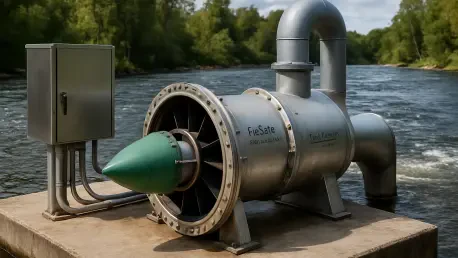What if hydropower, a cornerstone of clean energy, could finally shed its reputation for harming aquatic life? Picture a turbine that powers communities while ensuring fish swim through unscathed—a dream that seems almost too good to be true. Yet, Natel Energy has turned this vision into reality with their FishSafe Restoration Hydro Turbine (RHT), a groundbreaking innovation boasting near-perfect fish survival rates. This isn’t just a technological tweak; it’s a seismic shift for an industry long criticized for its environmental toll. Dive into the story of how this turbine is setting a new standard for sustainable energy.
Why This Innovation Is a Game-Changer
The significance of this development cannot be overstated. Hydropower generates a substantial portion of global renewable energy, but traditional turbines often act as deadly obstacles for fish, particularly in regions with endangered species like salmon and steelhead. The disruption to ecosystems and local economies dependent on fisheries has fueled decades of debate. Natel Energy’s RHT emerges as a beacon of hope, proving that energy production and ecological preservation can coexist. This story matters because it addresses a critical challenge at the intersection of climate goals and biodiversity, offering a blueprint for a greener, more compassionate future.
The Deadly Dilemma of Traditional Hydropower
For years, the hydropower industry has grappled with a harsh reality: turbines can be lethal to fish. In areas like the Pacific Northwest, where salmon populations are already dwindling, downstream passage through conventional designs often results in injury or death. The economic and cultural stakes are high—fisheries support livelihoods and Indigenous traditions, yet aging infrastructure continues to exacerbate the problem. Environmentalists and industry leaders alike have sought solutions, but costly measures like fish-diverting screens frequently fall short in effectiveness. This persistent conflict underscores the urgent need for a better approach to balance energy demands with nature’s needs.
A Closer Look at the FishSafe RHT Design
At the heart of this revolution lies the FishSafe RHT, a turbine engineered with fish safety as a priority. Unlike traditional models, it features blades with thick leading edges and a forward slant, minimizing the risk and impact of strikes on fish. These subtle yet powerful design choices have yielded extraordinary outcomes. Testing at the Monroe Drop Hydro Project in Culver, Oregon, demonstrated immediate survival rates of 100% for hatchery-reared rainbow trout in initial trials, with a slight dip to 98.6% in subsequent tests, and no major injuries recorded. Additional studies with American eel and juvenile river herring also showed perfect survival rates, highlighting the turbine’s versatility across species.
The implications of these results are far-reaching. By reducing harm, the RHT could eliminate the need for expensive, often inefficient protective screens, cutting costs for operators while enhancing ecological outcomes. With operational units already spinning in Maine, Oregon, and Austria, and contracts secured for upgrades in the Eastern U.S. and Europe, this technology is proving its scalability. Feasibility studies for new sites across North America and Europe further signal a growing trust in its potential to redefine industry norms.
Voices from the Frontline of Innovation
Sterling Watson, Principal Engineer at Natel Energy, encapsulates the turbine’s promise with clarity: “The RHT’s high survival rates for fish, including adult salmonids, enable the hydropower sector to tackle downstream passage issues without compromising cost-effectiveness or efficiency.” This perspective is reinforced by a peer-reviewed study in Environmental and Sustainability Indicators, conducted with support from the U.S. Department of Energy’s Water Power Technologies Office and in collaboration with the Pacific Northwest National Laboratory. Watson’s optimism reflects a broader consensus among experts that this innovation could be transformative, especially for regions like the Northeast U.S., Atlantic Canada, and Europe, where endangered Atlantic salmon face ongoing threats from hydropower facilities.
Beyond the data, the real-world impact is already visible. In areas with threatened fish populations, the turbine offers a lifeline, potentially aiding recovery efforts for species critical to local ecosystems. The collaboration between research bodies and industry players, as seen in Natel’s partnerships, sets a precedent for how innovation can be validated and scaled. This synergy of science and application paints a compelling picture of what’s possible when environmental challenges meet cutting-edge solutions.
Transforming Hydropower for a Sustainable Tomorrow
The broader potential of the RHT lies in its ability to reshape hydropower practices worldwide. Retrofitting existing facilities with fish-safe technologies should be a priority, especially in high-impact zones like the Pacific Northwest, where species survival hangs in the balance. Operators and policymakers can take inspiration from Natel’s model of partnering with government programs and research institutions to test and deploy such advancements. These alliances ensure that solutions are not just theoretical but grounded in rigorous evidence.
Moreover, updating industry standards to incentivize fish-safe designs could accelerate adoption. Traditional protective measures, often outdated and cumbersome, need to be phased out in favor of integrated technologies like the RHT. For communities reliant on both clean energy and thriving fisheries, this turbine represents a practical step toward harmony. It’s a reminder that sustainability isn’t just about reducing carbon footprints—it’s about safeguarding every layer of the ecosystem.
Reflecting on a Milestone in Energy and Ecology
Looking back, the journey of Natel Energy’s FishSafe RHT marked a turning point in how hydropower’s environmental footprint was addressed. The near-perfect survival rates achieved for fish, coupled with the turbine’s operational efficiency, challenged long-standing assumptions about the trade-offs between energy and ecology. Its deployment across multiple regions stood as proof that innovation could bridge divides once thought insurmountable. For stakeholders, the path forward became clear: prioritize retrofitting high-risk facilities, foster collaborative research, and push for policies that champion fish-safe technologies. As the industry moved ahead, the hope was that such advancements would inspire a wave of solutions, ensuring that clean energy no longer came at the cost of aquatic life.









